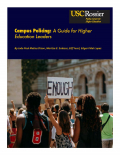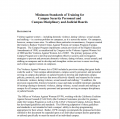Campus measures to increase safety include things like safe rides and campus escort programs, security cameras, emergency phones, safety patrols, and text notification systems. IHEs must also have procedures for responding to crime and violence, as well as services and supports for those who have experienced unsafe situations.
IHEs can improve students’ ability to keep themselves safe by communicating security basics—like always locking doors and not walking alone at night—and through opportunities like self-defense trainings. IHEs should also clearly communicate with everyone on campus about how and where students, faculty, and staff can report threats to safety.
Coordinated efforts between campus and community safety personnel are more effective than isolated endeavors. Campus and community security, law enforcement, and fire officials can create formal agreements about how they will communicate risks, respond to incidents, and follow up after an incident has occurred. They can also partner with organizations that can provide services to students who have experienced violations of their safety.
It's important to understand the unique roles campus and community safety officials play on individual campuses in order to best coordinate efforts and responses. For example, on some campuses, security officers do not have the power to make arrests and must rely on local law enforcement to do so.
Campus and community officials must also clearly delineate roles and responsibilities to avoid jurisdictional issues and delays in responding.
Bureau of Justice Assistance. Campus security guidelines: Recommended operational policies for local and campus law enforcement. Washington, DC: https://bja.ojp.gov/sites/g/files/xyckuh186/files/Publications/MCC_CampusSecurityGuidelines.pdf
Jed Foundation. (2022). Physical safety on campus. New York, NY: https://jedfoundation.org/set-to-go/physical-safety-on-campus/Morin, H. (nd.) Myth busting: Bullying on college campuses. University of San Francisco: https://myusf.usfca.edu/caps/bullying_on_college_campuses
NASPA. (2015). Campus safety and security: A team effort. Washington, DC: https://www.naspa.org/blog/campus-safety-and-security-a-team-effort
National Center for Education Statistics. (2020). New report on crime and safety in schools and on college campuses. Washington, DC: https://nces.ed.gov/blogs/nces/post/new-report-on-crime-and-safety-in-schools-and-on-college-campuses


